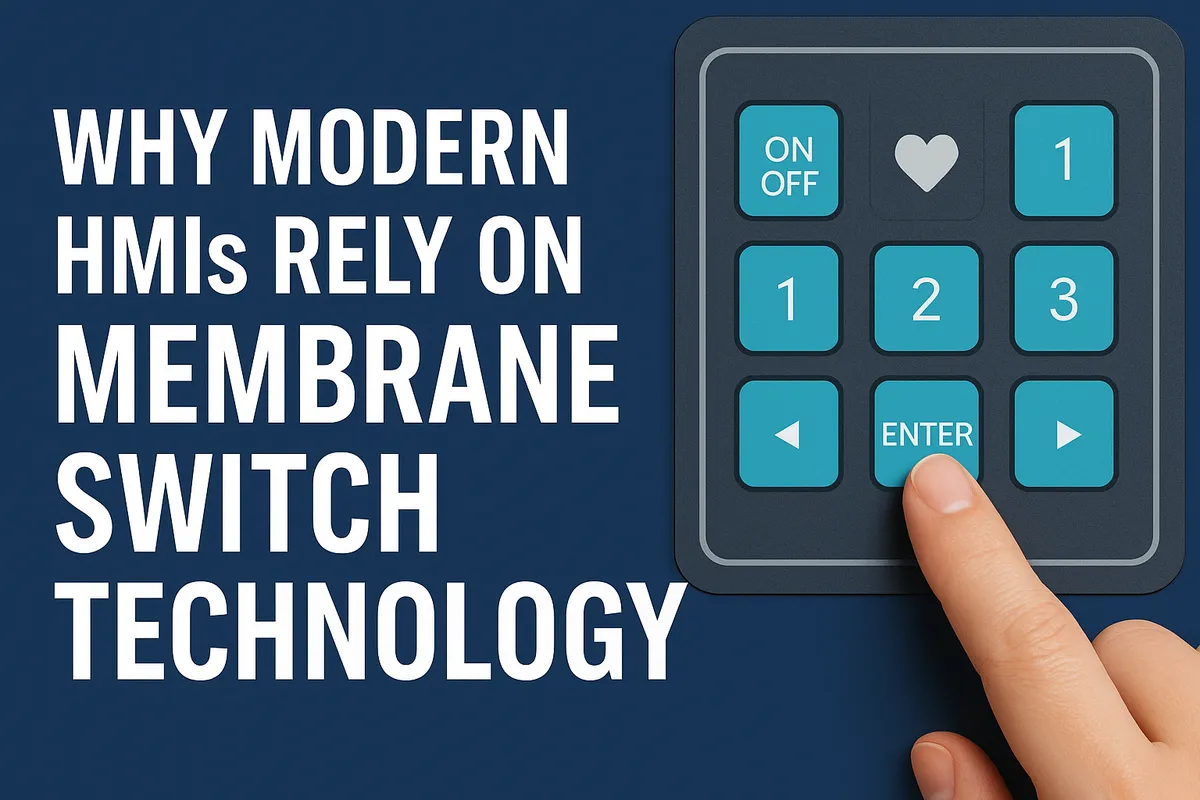A Guide to Membrane Switch Applications Across Industries
The versatility of membrane switch technology makes it suitable for a vast range of applications, each leveraging different strengths of the design.

Why Modern HMIs Rely on Membrane Switch Technology
From medical labs to factory floors, the way we interact with machines has transformed. Clunky, mechanical buttons are rapidly being replaced by sleek, reliable, and highly customized interfaces. At the forefront of this evolution is the membrane switch—a technology that offers a unique combination of durability, design freedom, and sealed protection.
But what exactly is a membrane switch, and why have they become the go-to choice for engineers and procurement managers across so many industries? This guide explores the core advantages and the most common membrane switch applications to help you understand if this technology is the right fit for your next project.
What is a Membrane Switch?
A membrane switch is a momentary switching device manufactured by printing conductive inks onto a flexible substrate like polyester. Unlike a traditional mechanical switch, it has no moving parts in the conventional sense. Instead, it consists of multiple thin layers sealed together.
When a user presses a specific area on the top layer (the graphic overlay), it flexes through a spacer and makes contact with a lower circuit layer, momentarily closing the circuit. The result is a reliable, low-profile, and highly durable human-machine interface (HMI).
Key Advantages Over Traditional Switches
The shift toward membrane switch technology is driven by several key advantages that address the primary pain points of modern product design and manufacturing.
- Complete Environmental Sealing: Because the layers are sealed with industrial adhesives, a membrane switch assembly is inherently resistant to moisture, dust, and chemicals. This allows for high IP ratings (like IP65 and IP67), making them ideal for harsh environments.
- Exceptional Durability and Reliability: With no significant mechanical moving parts to wear out, membrane switches are rated for millions of actuations, ensuring a long operational life and reducing field failures.
- Unlimited Customization: The top graphic overlay can be printed with any color, branding, or legend. This allows for complete design freedom to match a product’s aesthetic and functional requirements, including options for transparent display windows and backlighting.
- Cost-Effectiveness at Scale: For medium to high-volume production, the manufacturing process is highly efficient, leading to a lower total cost of ownership compared to assembling and wiring individual mechanical switches.
- Low-Profile and Easy Integration: Their thin, flexible design makes them easy to mount on any enclosure, saving valuable space and simplifying the assembly process.
Common Membrane Switch Applications Across Industries
The versatility of membrane switch technology makes it suitable for a vast range of applications, each leveraging different strengths of the design.
Medical & Healthcare Devices
In sterile environments, cleanability is non-negotiable. Membrane switches provide a seamless, crevice-free surface that is easy to wipe down and disinfect without risking damage to the electronics. Their resistance to cleaning chemicals and their proven reliability are why they are standard in patient monitoring systems, infusion pumps, and laboratory analysis equipment.
Industrial Controls & Automation
Factory floors are tough on equipment. Industrial HMI panels must withstand dust, vibration, and frequent use, often by operators wearing gloves. A custom membrane switch can be designed with thick, durable materials and embossed keys or metal domes to provide strong tactile feedback, ensuring error-free operation of PLC controls, machinery interfaces, and processing equipment.
White Goods & Consumer Appliances
Modern kitchen and home appliances compete on both performance and aesthetics. A membrane switch provides a sleek, modern look that is easy to clean and resistant to spills—perfect for ovens, washing machines, and coffee makers. The ability to create a custom graphic overlay allows brands to create a signature look and feel while keeping production costs in check.
Kiosks, Vending & Public Terminals
Interfaces used in public spaces need to be exceptionally rugged. Membrane keypads offer excellent vandal and moisture resistance. With options for UV-stable overlays to prevent fading and integrated backlighting for low-light visibility, they are a reliable choice for ticketing machines, self-service kiosks, and fuel dispensers.
Agriculture & Construction Equipment
From tractor cabs to outdoor control stations, equipment in these sectors must perform in extreme temperatures, heavy rain, and high-dust conditions. Fully sealed keypad solutions ensure that the HMI remains the most reliable part of the machine, with options for strong tactile feedback that can be easily operated with thick gloves.
Choosing the Right Manufacturing Partner
The performance of a membrane switch is directly tied to the quality of its design and manufacturing. When sourcing a supplier, procurement and operations managers should look for a partner who offers more than just production. Key indicators of a top-tier membrane switch manufacturer include:
- Deep Engineering Expertise: The ability to provide design support, from material selection to circuit layout, to optimize for your specific application.
- Proven Track Record: Decades of experience and a portfolio of successful projects across multiple industries signal reliability and consistency.
- Rapid Prototyping: The capability to produce functional prototypes quickly allows for design validation and testing before committing to mass production.
Frequently Asked Questions (FAQ)
What is the typical lifespan of a membrane switch? A high-quality membrane switch is typically rated for 1 to 3 million actuations, ensuring a long operational life even in high-use applications.
Can membrane switches be used outdoors? Yes. By using UV-resistant overlay materials and ensuring a proper seal (IP65 or higher), membrane switches are well-suited for outdoor use where they may be exposed to sunlight and moisture.
What is the difference between tactile and non-tactile feedback? Tactile feedback provides a distinct “snap” or click that the user can feel, typically achieved with embedded metal or polyester domes. Non-tactile switches have no physical click, and feedback is usually provided by an audible beep or a visual indicator on the screen.
